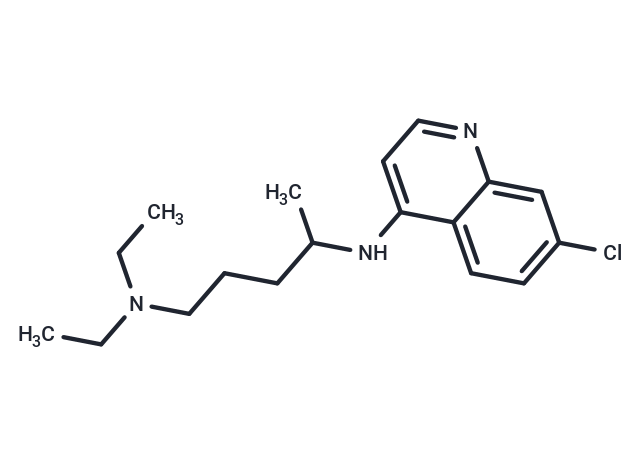Shopping Cart
Remove All Your shopping cart is currently empty
Your shopping cart is currently empty
Chloroquine is a Toll-like receptor inhibitor that inhibits autophagy. Chloroquine has anti-malarial and anti-inflammatory activity and is widely used in the treatment of malaria and rheumatoid arthritis. Chloroquine also has anti-SARS-CoV-2 (COVID-19) activity and anti-HIV-1 activity.

| Pack Size | Price | USA Warehouse | Global Warehouse | Quantity |
|---|---|---|---|---|
| 50 mg | $30 | In Stock | In Stock | |
| 100 mg | $42 | In Stock | In Stock | |
| 500 mg | $145 | In Stock | In Stock | |
| 1 mL x 10 mM (in DMSO) | $40 | In Stock | In Stock |
| Description | Chloroquine is a Toll-like receptor inhibitor that inhibits autophagy. Chloroquine has anti-malarial and anti-inflammatory activity and is widely used in the treatment of malaria and rheumatoid arthritis. Chloroquine also has anti-SARS-CoV-2 (COVID-19) activity and anti-HIV-1 activity. |
| Targets&IC50 | HIV-1:~6 μg/mL, SARS-CoV:8.8 ± 1.2 μM |
| In vitro | METHODS: Human cholangiocarcinoma cells QBC939 were treated with Chloroquine (1.2-200 µM) for 24 h. Cell growth inhibition was detected by MTT. RESULTS: Chloroquine dose-dependently inhibited the cell growth of HRECs with an IC50 of 53.01 µM. [1] METHODS: Human non-small cell lung cancer cells A549 were treated with Chloroquine (10-80 μM) for 24 h. The expression levels of target proteins were detected by Western Blot. RESULTS: Chloroquine induced an increase in LC3-II expression and a decrease in LC3-I expression, resulting in an increase in the LC3-II/LC3-I ratio. The highest LC3-II/LC3-I ratio was observed with 40 μM Chloroquine treatment. [2] METHODS: Human osteosarcoma cells U2OS and human cervical cancer cells HeLa were treated with Chloroquine (100 μM) for 5 h. LAMP1, a marker protein for late endosomal compartment and lysosome, was detected by Immunofluorescence. RESULTS: Chloroquine increased the area of LAMP1 positive structures. [3] |
| In vivo | METHODS: To investigate the effects of Chloroquine on acute liver injury and its potential molecular mechanisms, a single dose of Chloroquine (5-50 mg/kg) was administered intraperitoneally to C57BL/6 mice 2-24 h before CCl4 (10 mL/kg) injection. RESULTS: Chloroquine pretreatment significantly inhibited CCl4-induced acute liver injury, as evidenced by a decrease in serum aminotransferases, aspartate aminotransferase, and a decrease in the histological score of liver injury, and down-regulated CCl4-induced high-mobility histone 1 (HMGB1) expression in liver tissues as well as the levels of serum HMGB1, IL-6, and TNF-α. levels. [4] METHODS: To investigate the relationship between Chloroquine and retinopathy, Chloroquine (50 mg/kg ) was administered intraperitoneally to C57/BL6 mice three times a week for six weeks. RESULTS: Chronic administration of Chloroquine induced retinopathy in mice. mRNAs for IL-1β mRNA, a component of inflammatory vesicles, and caspase1 were increased in the retinas of Chloroquine-treated mice, consistent with the initiation of inflammatory vesicles, and NTPDase1 was increased, suggesting an increase in extracellular ATP in the retina. [5] |
| Synonyms | CQ |
| Molecular Weight | 319.87 |
| Formula | C18H26ClN3 |
| Cas No. | 54-05-7 |
| Smiles | CCN(CC)CCCC(C)Nc1ccnc2cc(Cl)ccc12 |
| Relative Density. | 1.0500 g/cm3 (Estimated) |
| Storage | keep away from direct sunlight | Powder: -20°C for 3 years | In solvent: -80°C for 1 year | Shipping with blue ice/Shipping at ambient temperature. | |||||||||||||||||||||||||||||||||||
| Solubility Information | DMSO: 45 mg/mL (140.68 mM), Sonication is recommended. H2O: < 1 mg/mL (insoluble or slightly soluble) Ethanol: 100 mg/mL (312.63 mM), Sonication is recommended. | |||||||||||||||||||||||||||||||||||
| In Vivo Formulation | 10% DMSO+40% PEG300+5% Tween 80+45% Saline: 5.25 mg/mL (16.41 mM), Suspension. Please add the solvents sequentially, clarifying the solution as much as possible before adding the next one. Dissolve by heating and/or sonication if necessary. Working solution is recommended to be prepared and used immediately. The formulation provided above is for reference purposes only. In vivo formulations may vary and should be modified based on specific experimental conditions. | |||||||||||||||||||||||||||||||||||
Solution Preparation Table | ||||||||||||||||||||||||||||||||||||
DMSO/Ethanol
| ||||||||||||||||||||||||||||||||||||
| Size | Quantity | Unit Price | Amount | Operation |
|---|

Copyright © 2015-2025 TargetMol Chemicals Inc. All Rights Reserved.